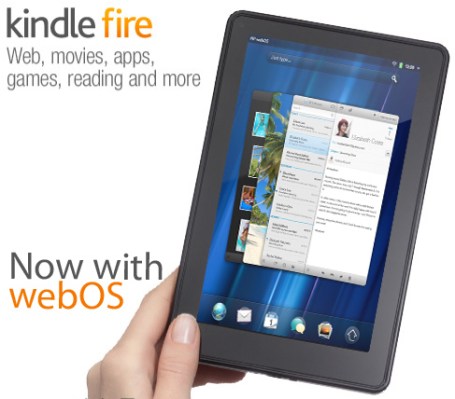The Kindle Fire announcement set the interwebs ablaze as Amazon burst into the tablet scene. But the retailer-turned-CE player might be looking to go a different way in the future. Amazon has been named as Palm’s current top suitor among “a handful of contenders” as HP looks to rid itself from the TouchPad/webOS disaster.
It’s unclear from VentureBeat’s leaks why Amazon is interested in Palm. Ditching Android for webOS after building an ecosystem around Android seems foolish and shortsighted. This move, if it’s really happening, could be more about hardware development and patents than reviving a dead operating system. Sorry, fanboys.
Amazon launched the Kindle Fire earlier this week, which brings nearly all of Amazon’s cloud services into one device. Even Amazon’s massive cloud servers, Amazon EC2, are used in the clever Silk browser and the Amazon Appstore finally has flagship device in the Fire. Amazon rebuilt its Kindle syncing platform, Whispersync, to enable resuming of TV shows and movies purchased or streamed using its Prime Instant Vidoes Android app. The Fire is the compilation of a lot of Amazon’s work — and it’s all built around Android.
Adding a second tablet to Amazon’s offering seems to go against the Kindle brand’s mantra of keeping it simple. The Fire isn’t about Android or specs. It’s a tablet built around the same principles as the iPad. By bringing webOS into the fold, Amazon turns the attention to the platform, capabilities and differences rather than the form and function. A webOS Kindle doesn’t make sense.
Instead, if Amazon is indeed looking to acquire Palm from HP, the company could be looking to acquire a proper hardware design team. Amazon reportedly outsourced the Fire’s development to Quanta, who, as Ryan Block puts it, “helped them shortcut the development process by using the PlayBook as their hardware template.” Amazon is clearly going all-in on tablets and will need the right principles in place for future products. However, Palm, and even HP, have never been known to make killer hardware so even this motive is a bit questionable.
The notion of Amazon buying Palm seems a bit untimely at this point. Amazon is fully vested in the Android ecosystem with a host of apps and services. Plus, the Android-powered Fire is seemingly a hit. The install base of webOS, even after the $99 TouchPad fire sale, isn’t large enough to compensate the upfront cost and effort resurrecting a dead platform. Palm off-loaded most pre-webOS patents before HP acquired the company in 2010 so Amazon would only be purchasing whatever patents were left over or granted within the last few years.
Steve Ballmer proudly proclaimed that Android isn’t free and his company is constantly signing new Android licensing agreements. In fact Microsoft reportedly makes more money from Android than its own Windows Phone 7. Amazon’s only play, and this is a stretch given the company’s Android investment, would be to buy webOS upfront to avoid any potential deals with Microsoft down the road. Some companies are fighting Microsoft’s patents but others, including Samsung, HTC and Acer, have already signed on the dotted line.
From this vantage point outside of Amazon’s boardrooms, it doesn’t seem like Amazon needs Palm or webOS. The company did a fine job retooling Android into a consumer-friendly offering and is the only company outside of Apple to supplement hardware with a rich set of services and media, properly setting up the Fire for success. But if the price is right and Amazon foresees a legal battle with Microsoft, it’s completely plausible Amazon will be the next owner of the company that first innovated and advanced touchscreen tablets.
